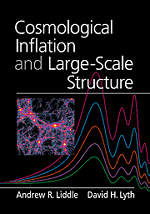Book contents
- Frontmatter
- Contents
- Frequently used symbols
- Preface
- 1 INTRODUCTION
- 2 THE HOT BIG BANG COSMOLOGY
- 3 INFLATION
- 4 SIMPLEST MODEL FOR THE ORIGIN OF STRUCTURE I
- 5 SIMPLEST MODEL FOR THE ORIGIN OF STRUCTURE II
- 6 EXTENSIONS TO THE SIMPLEST MODEL
- 7 SCALAR FIELDS AND THE VACUUM FLUCTUATION
- 8 BUILDING AND TESTING MODELS OF INFLATION
- 9 THE COSMIC MICROWAVE BACKGROUND
- 10 GALAXY MOTIONS AND CLUSTERING
- 11 THE QUASI-LINEAR REGIME
- 12 PUTTING OBSERVATIONS TOGETHER
- 13 OUTLOOK FOR THE FUTURE
- 14 ADVANCED TOPIC: COSMOLOGICAL PERTURBATION THEORY
- 15 ADVANCED TOPIC: DIFFUSION AND FREESTREAMING
- Appendix: Constants and parameters
- Numerical solutions and hints for selected examples
- References
- Index
13 - OUTLOOK FOR THE FUTURE
Published online by Cambridge University Press: 05 June 2012
- Frontmatter
- Contents
- Frequently used symbols
- Preface
- 1 INTRODUCTION
- 2 THE HOT BIG BANG COSMOLOGY
- 3 INFLATION
- 4 SIMPLEST MODEL FOR THE ORIGIN OF STRUCTURE I
- 5 SIMPLEST MODEL FOR THE ORIGIN OF STRUCTURE II
- 6 EXTENSIONS TO THE SIMPLEST MODEL
- 7 SCALAR FIELDS AND THE VACUUM FLUCTUATION
- 8 BUILDING AND TESTING MODELS OF INFLATION
- 9 THE COSMIC MICROWAVE BACKGROUND
- 10 GALAXY MOTIONS AND CLUSTERING
- 11 THE QUASI-LINEAR REGIME
- 12 PUTTING OBSERVATIONS TOGETHER
- 13 OUTLOOK FOR THE FUTURE
- 14 ADVANCED TOPIC: COSMOLOGICAL PERTURBATION THEORY
- 15 ADVANCED TOPIC: DIFFUSION AND FREESTREAMING
- Appendix: Constants and parameters
- Numerical solutions and hints for selected examples
- References
- Index
Summary
The present situation looks very good for the inflationary cosmology. As we hope that we have demonstrated, the picture of structure formation based on the inflationary cosmology is very complete and elegant, bringing together quantum theory for the origin of the perturbations, general relativity for their evolution, and a variety of astrophysical processes to make the final link to observations.
Inflation-based structure formation models appear an excellent paradigm within which to understand the inhomogeneous Universe in which we live, even though, as we write, it is rather unclear precisely which type of model might best fit the data. For instance, should the Universe have critical density, and if so, is a component of hot dark matter necessary? Should it instead have lower density, with or without a cosmological constant? What is clear is the success of the basic paradigm, that everything originates from a Gaussian, adiabatic, density perturbation with spectral index close to 1.
For the future, we await improved observations to see if this picture can be sustained. Many types of observation will probe the cosmological modelling and, for inflationary cosmologists, none is more eagerly awaited than improved measurements of the microwave background anisotropies, which directly probe linear perturbation theory. The Microwave Anisotropy Probe and Planck satellites promise data of unprecedented quality when it comes to constraining inflationary and cosmological parameters, and before then, many ground- and balloon-based experiments should accurately probe at least the first acoustic peak; for them, any significant spatial curvature is easy prey, and other parameters may be pinned down too.
- Type
- Chapter
- Information
- Cosmological Inflation and Large-Scale Structure , pp. 314 - 315Publisher: Cambridge University PressPrint publication year: 2000



